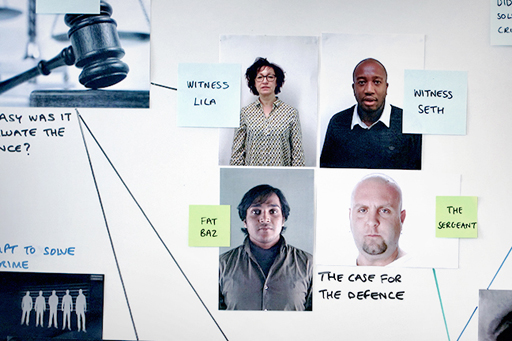1.2 The case for the defence

The defence team have hired you as an expert psychologist and asked you to work through the prosecution defence and report any problems you can see. Below are the key pieces of evidence being used by the prosecution.
Think about each one carefully in light of all you have learned about the psychology of eyewitnesses and police investigations. Is the evidence sound?
- The initial statements provided by the two eyewitnesses are consistent in terms of describing what happened
- The interviews with both eyewitnesses provide detailed descriptions that are a very good match for the two men accused
- Several members of the public identified the accused from the Photofits
- Both eyewitnesses identified the two men accused in line-ups.
Following is an activity to test your evaluation of the evidence. Each question contains one of the pieces of evidence above and several potential ways of evaluating it. One of these evaluations was provided by a psychological expert on eyewitness testimony that has acted as an expert witness in court. See if your evaluation matches theirs.
Activity 1 Evaluate the prosecution’s evidence (DI Bullet’s case)
a.
Reliable, because two people remembering the same facts is better than the memory of just one.
b.
Unreliable, because the crime was violent and research has shown that this puts witnesses under a great deal of stress which leads to them having very poor memories.
c.
Reliable, as it is important to corroborate evidence, and here the evidence from one witness corroborates that from the other.
d.
Unreliable, because the two witnesses heard each other’s accounts. This would have lead them to alter their own account so as to be consistent with that of the other witness.
The correct answer is d.
d.
Correct! The co-witnessing effect makes this evidence unreliable.
a.
Unreliable, because of the approach to interviewing that was taken, which included many leading questions.
b.
Reliable, because both witnesses provided similar descriptions.
c.
Unreliable, because witnesses are just unable to provide accurate descriptions of the appearance of a perpetrator.
d.
Reliable, because the witnesses were interviewed separately, thus avoiding the effects of co-witnessing.
The correct answer is a.
a.
This is the correct answer. Much of the evidence collected by DI Bullet was actually first suggested by him in leading questions in order to confirm his existing theories.
You may find 3.3.5 Types of questions useful.
a.
Unreliable, because not every person who saw the photofits identified the accused.
b.
Unreliable, because facial composites generate potential suspects and should not be used as evidence concerning the identity of the perpetrator.
c.
Reliable, because several members of the public identified the same person.
d.
Reliable, as the composites did resemble the two people being accused.
The correct answer is b.
a.
Reliable, as both witnesses picked the same two people.
b.
Reliable, because a simultaneous style was used to present the images in the identification parade.
c.
Unreliable, as not only were biased instructions and unfair parades used, but the witnesses may have identified the accused due to unconscious transference.
d.
Unreliable, because nine photographs were used and this is just too many for a witness to deal with effectively.
The correct answer is c.
c.
This is correct. The instructions used by DI Bullet strongly suggested that the perpetrator was definitely present in the parade, not all of the pictures were a good match for the suspect and the witness had seen photos of the suspects previously in a mug-shot album, which could have lead to unconscious transference.
Have a look back at Week 6.
